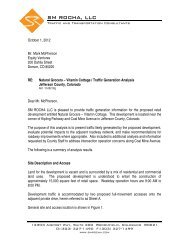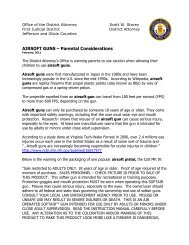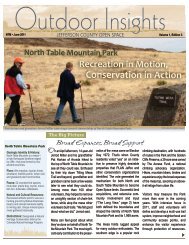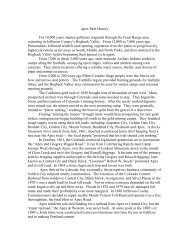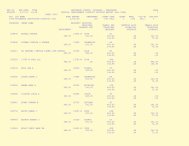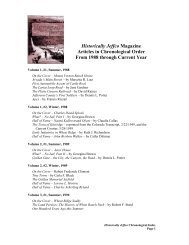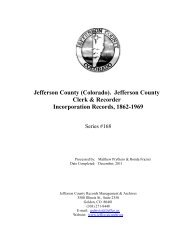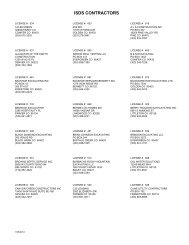Pine Valley Ranch Park Historical Background: - Jefferson County
Pine Valley Ranch Park Historical Background: - Jefferson County
Pine Valley Ranch Park Historical Background: - Jefferson County
You also want an ePaper? Increase the reach of your titles
YUMPU automatically turns print PDFs into web optimized ePapers that Google loves.
<strong>Pine</strong> <strong>Valley</strong> <strong>Ranch</strong> <strong>Park</strong> <strong>Historical</strong> <strong>Background</strong><br />
Gold seekers followed dreams of riches up <strong>Pine</strong> <strong>Valley</strong> on their way to Leadville, first on<br />
foot or mule, and later on the narrow gauge railroad. In the early 1860s ranchers began<br />
homesteading in the area, while other settlers quickly turned to cutting timber and<br />
building sawmills. The timber industry, although not as glamorous as discovering gold<br />
and silver, was a significant force in Colorado’s frontier development. By 1870 the <strong>Pine</strong><br />
<strong>Valley</strong> area had 11 sawmills and eagerly supplied Denver’s growing demand for lumber<br />
and railroad ties.<br />
A town was established in August 1866. The Denver, South <strong>Park</strong> & Pacific, a 3-foot<br />
narrow gauge line, first arrived in <strong>Pine</strong> Grove from Denver in 1878. That summer, both<br />
passenger and freight service began and continued for 59 years, after which the right-ofway<br />
reverted to ranches along the line. <strong>Pine</strong> Grove was the first fueling station west of<br />
Denver, and was the base of operations for several helper engines and their crews.<br />
Helper engines were attached to heavily laden trains to help push them up the steep<br />
mountains and over the passes. Upon reaching the pass, the helper engine was uncoupled<br />
and returned to its base to await the next train.<br />
The 42-mile trip from Denver to <strong>Pine</strong> Grove took 2 ½ hours and cost each passenger<br />
$1.50. After delivering all the picnickers and fishermen to local resorts like <strong>Pine</strong> Grove<br />
and Crystal Lake, the train veered off onto a temporary spur for an occasional stop at<br />
<strong>Pine</strong> <strong>Valley</strong> <strong>Ranch</strong>. This train stop was named “Hildebrand” after the original<br />
homesteader. When the Baehr family purchased the ranch in 1925, they named their stop<br />
“Baehrden,” and the depot’s large black and white sign hung above the tracks near the<br />
river.<br />
In the late 19 th century J.W. Hildebrand, Thomas Busher, and the Liming family<br />
homesteaded <strong>Pine</strong> <strong>Valley</strong>. In 1908, Charlie Eggert, owner of the Eggert Ice Company of<br />
Denver, purchased the property to be used for harvesting ice from the many nearby lakes,<br />
most of which he had built and owned. Eggert’s ice operations in the <strong>Pine</strong> area continued<br />
well into the 1920s, and ice cutting was a major industry, employing many people in the<br />
<strong>Pine</strong> area.<br />
William B. Baehr, president of Chicago’s North Continent Utilities Company, a major<br />
electrical, natural gas and hydroelectric company, vacationed in Colorado in 1925. Baehr<br />
visited the <strong>Pine</strong> <strong>Valley</strong> area, fell in love with what he saw, and decided it was the ideal<br />
spot to build a summer home for his family. Baehr had visited Europe where he admired<br />
various Bavarian hunting lodges, and dreamed of a lodge of his own. <strong>Pine</strong> <strong>Valley</strong> was<br />
the perfect setting for his dream, and Baehr soon bought the <strong>Pine</strong> <strong>Valley</strong> property.<br />
Along with a dream, William Baehr had influence and money. Baehr hired Jacques J. B.<br />
Benedict to make his dream a reality. Benedict was Colorado’s first Beaux-Arts trained<br />
architect, and had travelled widely, including architectural schooling in Paris. Benedict<br />
had a thriving urban architectural practice, and had completed several private mountain<br />
lodge-like residences and several projects for the Denver Mountain <strong>Park</strong>s, including
Chief Hosa Lodge in 1920. Benedict continued as one of Denver’s leading architects<br />
until 1940.<br />
Baehr Lodge’s quality of construction is the result of Benedict’s attention to detail and<br />
rigid, direct control over contractors and workers. His closely supervised crew of 60<br />
skilled workmen, working around the clock for 90 days, completed construction during<br />
the summer of 1927, at a cost of $1.5 million.<br />
Baehr Lodge is a 27-room lodge, complete with wrought iron fixtures (forged on site),<br />
arched ceilings, hand etched log paneling, railings and balconies. Two distinctive<br />
octagonal roof towers, tall stone chimneys, and multiple steeply pitched gables create<br />
Baehr’s desired image of a Bavarian hunting lodge amid the Colorado Rockies.<br />
Conrad Johnson began working for William Baehr on the 4-L <strong>Ranch</strong>, as it was named<br />
when Baehr purchased it, in the late 1920s, as a chauffeur, handyman, gardener, and<br />
maintenance man. Johnson became foreman in 1930, and launched a building<br />
improvement program which included construction of: concrete bridges; a new garage;<br />
the powerhouse including installation and maintenance of the Kohler gasoline-powered<br />
light plants; equipment sheds; a 10,000 gallon water tank; a water wheel to pump the<br />
water to the tank, an irrigation system; a gardener’s house; and miles of new fences<br />
around the ranch.<br />
William Baehr was passionately interested in astronomy, so in 1937 Johnson and his<br />
children built an observatory, and in 1939 a Japanese-style pagoda was built on an island<br />
in the river, where Mrs. Baehr enjoyed picnicking and sharing afternoon tea with friends.<br />
Baehr and his wife, Mabel, had only two children, a son, William, and a daughter, Irene.<br />
Baehr’s daughter, Irene Baehr Eklund, at age 93, is still living near Chicago. According<br />
to Baehr’s great nephew, Herb Allen, who spent his eighth summer at the Baehr Den,<br />
William Baehr was a man who loved to be surrounded by his extended family and<br />
friends, and always brought some of them with him to spend their summer on his ranch.<br />
Following William Baehr’s death, <strong>Pine</strong> <strong>Valley</strong> <strong>Ranch</strong> was sold in 1956 to a private group<br />
of wealthy Denver families, among them Francis Van Derbur, Helen Bonfils, William<br />
Boyd, and Dr. James Rae Arneill, Jr. They used the property as a vacation spot and<br />
fishing retreat until 1975, when they sold <strong>Pine</strong> <strong>Valley</strong> <strong>Ranch</strong> to the Winegard Realty<br />
Corporation of Burlington, Iowa.<br />
New cabins were built, a swimming pool, sauna and dining room were added, and the<br />
ranch operated as a conference center and family resort for about 11 years. <strong>Pine</strong> <strong>Valley</strong><br />
<strong>Ranch</strong> was purchased by <strong>Jefferson</strong> <strong>County</strong> Open Space in February, 1986, for $2.35<br />
million. Development of the park was delayed for a number of years by the proposed<br />
construction of the Two Forks Dam. About $1.5 million was spent to construct amenities<br />
prior to opening <strong>Pine</strong> <strong>Valley</strong> <strong>Ranch</strong> <strong>Park</strong> in July 1994. On June 10, 1998, Baehr Lodge/
Baehr Den of the Rockies was listed in the State Register of Historic Properties in<br />
recognition of its contributions to the heritage of the State of Colorado.



